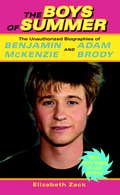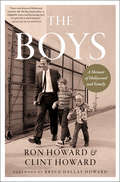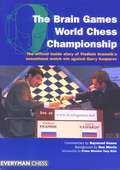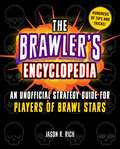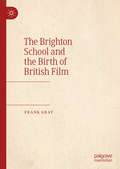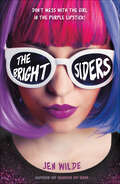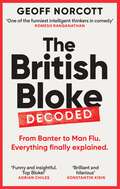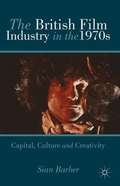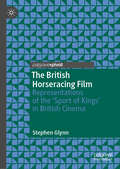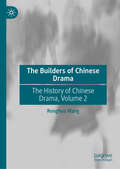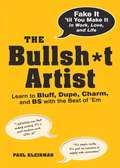- Table View
- List View
The Boys of Summer
by Elizabeth ZackTWO HOT TO HANDLE Thanks to the explosive popularity of Fox's hit television show The O. C. , actors Benjamin McKenzie and Adam Brody are men on the move. Their jaw-dropping good looks and impressive talent have catapulted them to the top of the It-list, making them two of Hollywood's hottest hunks. If you want to know how these gorgeous guys arrived in Orange County, look no further. The Boys of Summer gives you the complete 411 on Benjamin McKenzie and Adam Brody-hometown histories, dating dilemmas, and favorite pastimes. Find out about Ben's adventures in New York City as he pursued his passion for acting. Discover the other projects Adam has tackled, including Gilmore Girls and the horror flick The Ring. And, of course, get all the behind-the-scenes gossip from the set of The O. C. Ben and Adam have just begun to unleash their talent-stay tuned and see what lies ahead!
The Boys: A Memoir of Hollywood and Family
by Ron Howard Clint HowardHappy Days, The Andy Griffith Show, Gentle Ben—these shows captivated millions of TV viewers in the ’60s and ’70s. Join award-winning filmmaker Ron Howard and audience-favorite actor Clint Howard as they frankly and fondly share their unusual family story of navigating and surviving life as sibling child actors. <p><p> “What was it like to grow up on TV?” Ron Howard has been asked this question throughout his adult life. in The Boys, he and his younger brother, Clint, examine their childhoods in detail for the first time. For Ron, playing Opie on The Andy Griffith Show and Richie Cunningham on Happy Days offered fame, joy, and opportunity—but also invited stress and bullying. For Clint, a fast start on such programs as Gentle Ben and Star Trek petered out in adolescence, with some tough consequences and lessons. <p><p> With the perspective of time and success—Ron as a filmmaker, producer, and Hollywood A-lister, Clint as a busy character actor—the Howard brothers delve deep into an upbringing that seemed normal to them yet was anything but. Their Midwestern parents, Rance and Jean, moved to California to pursue their own showbiz dreams. But it was their young sons who found steady employment as actors. Rance put aside his ego and ambition to become Ron and Clint’s teacher, sage, and moral compass. Jean became their loving protector—sometimes over-protector—from the snares and traps of Hollywood. <p><p> By turns confessional, nostalgic, heartwarming, and harrowing, THE BOYS is a dual narrative that lifts the lid on the Howard brothers’ closely held lives. It’s the journey of a tight four-person family unit that held fast in an unforgiving business and of two brothers who survived “child-actor syndrome” to become fulfilled adults.
The Brain Games World Chess Championship
by Raymond Keene Don MorrisThe dramatic World Championship match in which Vladimir Kramnik surprisingly overthrew Garry Kasparov, the highest rated chess champion in the history of the game was, thanks to the internet, followed by more chess enthusiasts than any other chess championship match in chess history. For a month the eyes of the world were focused on the Riverside Studios in Hammersmith where the two grandmasters fought out their silent duel for two million dollars in prize money and the solid silver Howard Staunton trophy valued at N25,000 and crafted by Asprey and Garrard, the Queen's jewellers.
The Brawler's Encyclopedia: An Unofficial Strategy Guide for Players of Brawl Stars
by Jason RichThe Must-Own Insider's Guide to the Gaming Sensation! Brawl Stars is one of the latest real-time multiplayer gaming phenomena to captivate players all over the world. Players team up in threes to navigate mazes, shoot at enemies, and collect colorful gem stones. In order to triumph, players must react quickly, aim precisely, and develop strategy to perform well in each three-minute match. To keep the game interesting, Brawl Stars offers several unique game play modes, each focusing on a different primary challenge. With the valuable tips in this illustrated, information-packed guide, gamers will be better equipped to: Develop strategies for success at each different level. Master the various playing arenas (mazes) and snag more wins. Take advantage of the unique features of each gameplay mode. The Brawler's Encyclopedia will introduce young readers to this exciting and challenging game. This full-color how-to guide includes hundreds of full-color screenshots showcasing some of the more collectible skins that can be unlocked or purchase and explaining all aspects of the game in a way that appeals to newbs and experienced gamers.
The Bremen Town Musicians
by Ilse PlumeThe book is all about the four aged animal friends trying to make living for them as they were escaped from their cruel masters.
The Bremen-Town Musicians
by Ruth Belov GrossOn their way to Bremen-town, a donkey, a cat a rooster, and a dog, all planning on a new career in music, serenade some robbers.
The Bressonians: French Cinema and the Culture of Authorship
by Codruţa MorariHow should we understand film authorship in an era when the idea of the solitary and sovereign auteur has come under attack, with critics proclaiming the death of the author and the end of cinema? The Bressonians provides an answer in the form of a strikingly original study of Bresson and his influence on the work of filmmakers Jean Eustache and Maurice Pialat. Extending the discourse of authorship beyond the idea of a singular visionary, it explores how the imperatives of excellence function within cinema’s pluralistic community. Bresson’s example offered both an artistic legacy and a creative burden within which filmmakers reckoned in different, often arduous, and altogether compelling ways.
The Bridges of Summer
by Brenda SeabrookeIn the Bridges of Summer, a Junior Library Guild selection, Sarah Jane Brown who calls herself Zarah didn't remember her grandmother who lived on a jungly island in South Carolina. She wanted to stay in New York City and her life of ballet and acting but her mom had this opportunity to sing with Johnny and the Maroons on tour for the summer and off she went sending Zarah by herself to find Domingo Island and her grandmother Quanamina. It was worse than Zarah had thought: no running water, no electricity, no stores, no microwaves, yogurt, TV, a grandmother ruled by superstitions, a small cousin Loomis who scratched the dirt yard with a twig broom and was afraid of owls and a lot of other things. Zarah is afraid of snakes and failing like her talented but flighty mother. She meets Benicia from California visiting her grandmother on the next island and the two become friends until their grandmothers almost wreck it. That summer Zarah crosses bridges she didn't even know were there.
The Bright Way: Five Steps to Freeing the Creative Within
by Diana RowanThe Bright Way is an interactive handbook for mastering Diana Rowan’s proven system for freeing your innate creativity. The Bright Way System has helped thousands of creatives regain their inspiration and motivation, and move past fears so that they can courageously share their visions with the world. It is based on these three principles: 1. Everyone is creative. Creativity happens whenever you directly engage with your chosen activity. (It isn’t just for artists!) 2. You must be creative to be fulfilled in life. If you’re unengaged with life, you will feel dissatisfied, like something is missing. Engage directly with life by reigniting your creativity so that you come back home to your true self. 3. You can tap into your creativity anytime, anyplace, at any age. It’s never too late, and no matter the circumstances, you can be creative. Written for all creatives from young adults to seniors, The Bright Way’s empowering and reliable system works for a lifetime to help you:move through creative blocks so that your creativity consistently flowstransform performance fear into joyful sharing of your workfinally let go of self-doubt and embrace unshakable self-confidenceInspired by Diana’s own journey from severe creative performance anxiety to a fulfilling career as a full-time artist, this handbook is packed with actionable tips and dozens of examples so that you can make this simple yet powerful system truly your own. Start your Bright Way journey today to access your unique creative voice and shine your light in our new world!
The Brighton School and the Birth of British Film
by Frank GrayThis study is devoted to the work of two early British filmmakers, George Albert Smith and James Williamson, and the films that they made around 1900. Internationally, they are known collectively as the ‘Brighton School’ and are positioned as being at the forefront of Britain’s contribution to the birth of film. The book focuses on the years 1896 to 1903, as it was during this short period that film emerged as a new technology, a new enterprise and a new form of entertainment. Beginning with a historiography of the Brighton School, the study goes on to examine the arrival of the first 35mm films in Britain, the first film exhibitions in Brighton and the first projection of film in Brighton. Both Smith and Williamson’s work features a progression from the production of single shot unedited films to multi-shot edited films. Their subject matter was inspired by a knowledge of contemporary pantomime, humour, literature, theatre, mesmerism, the magic lantern and current affairs and their practices were underpinned by active involvement in the new film trade. Through the exploration of how these filmmakers cultivated a new way of understanding film and its commercial potential, this book establishes them as key figures in the development of British film culture.
The Brightsiders
by Jen WildeA teen rockstar has to navigate family, love, coming out, and life in the spotlight after being labeled the latest celebrity trainwreck in Jen Wilde's quirky and utterly relatable novel. As a rock star drummer in the hit band The Brightsiders, Emmy King’s life should be perfect. But there’s nothing the paparazzi love more than watching a celebrity crash and burn. When a night of partying lands Emmy in hospital, she’s branded the latest tabloid train wreck. Luckily, Emmy has her friends and bandmates, including the super-swoonworthy Alfie, to help her pick up the pieces of her life. She knows hooking up with a band member is exactly the kind of trouble she should be avoiding, and yet Emmy and Alfie Just. Keep. Kissing.Will the inevitable fallout turn her into a clickbait scandal (again)? Or will she find the strength to stand on her own?Jen Wilde, author of Queens of Geek, which Seventeen called, “the geeky, queer book of our dreams” is back with a brand new cast of highly diverse and relatable characters for her fans to fall in love with.Praise for Queens of Geek:"The book deals head on with issues of mental health, body shaming, sexuality, and internet celebrity, handling them with a delicate and skillful touch." —Teen Vogue"This fun book about fierce friendships gives voice to a group of diverse female characters who are so defined by so much more than just their mental health and sexuality." —Bustle"This celebration of geek culture and fandom promotes diversity and being true to oneself." —School Library Journal
The British Bloke, Decoded: From Banter to Man-Flu. Everything finally explained.
by Geoff Norcott'Geoff's examination of blokeness is Geoff all over - funny and insightful, making serious points without committing the cardinal sin of taking itself too seriously. Top bloke.' - Adrian Chiles'Highly informative. Geoff will make a proper bloke out of me yet.' - Hugo Rifkind'A brilliant and hilarious book which defends blokes without denigrating women' - Konstantin Kisin If you see a man drinking a pint in an airport pub alone, that's a bloke. If you see a man driving to the tip on a Saturday morning with a smile on his face, that's a bloke. And if you see a man heading back from the tip and on the way to the pub, that's a very happy bloke.The British Bloke appears simple and straightforward. He loves football, cricket, beer, sheds, wearing socks and books about the SAS.But beneath that simple exterior lies a mysterious and complex being.In The British Bloke Decoded, writer, comedian and regular bloke, Geoff Norcott peels back the layers of blokedom, revealing the truth behind the sometimes inexplicable behaviour of Britain's husbands, dads and brothers.Based on 46 years of field research and almost scientific insights, Geoff digs deep into subjects as wide as: the value of Banter, the surprising roots of Mansplaining, the near impossibility of getting blokes to send birthday cards, and whether there could be a medal system for Hoovering.And ultimately, he concludes that whilst the toxic men have been grabbing all the publicity - perhaps now's the time to celebrate the simple British bloke in all his eccentric splendour.
The British Bloke, Decoded: From Banter to Man-Flu. Everything finally explained.
by Geoff NorcottThe British Bloke appears simple and straightforward. He loves football, cricket, beer, sheds, wearing socks and books about the SAS.But beneath that simple exterior lies a mysterious and complex being.In The British Bloke Decoded, writer, comedian and regular bloke, Geoff Norcott peels back the layers of blokedom, revealing the truth behind the sometimes inexplicable behaviour of Britain's husbands, dads and brothers.Based on 46 years of field research and almost scientific insights, Geoff digs deep into subjects as wide as: the value of Banter, the surprising roots of Mansplaining, the near impossibility of getting blokes to send birthday cards, and whether there could be a medal system for Hoovering.And ultimately, he concludes that whilst the toxic men have been grabbing all the publicity - perhaps now's the time to celebrate the simple British bloke in all his eccentric splendour.WITH 4 BONUS CHAPTERS EXCLUSIVE TO THE AUDIOBOOK... including Wanna See My Sticker Collection? and How to Give Compliments (Without Arousing Suspicion) (p) 2023 Octopus Publishing Group
The British Bloke, Decoded: From Banter to Man-Flu. Everything finally explained.
by Geoff Norcott'I laughed a lot and now understand blokes a lot more than I ever wanted to' - Katherine Ryan'Geoff is one of the funniest intelligent thinkers in comedy and this book reflects that perfectly' - Romesh Ranganathan'Geoff's examination of blokeness is Geoff all over - funny and insightful, making serious points without committing the cardinal sin of taking itself too seriously. Top bloke.' - Adrian Chiles'Highly informative. Geoff will make a proper bloke out of me yet.' - Hugo Rifkind'A brilliant and hilarious book which defends blokes without denigrating women' - Konstantin Kisin If you see a man drinking a pint in an airport pub alone, that's a bloke. If you see a man driving to the tip on a Saturday morning with a smile on his face, that's a bloke. And if you see a man heading back from the tip and on the way to the pub, that's a very happy bloke.The British Bloke appears simple and straightforward. He loves football, cricket, beer, sheds, wearing socks and books about the SAS.But beneath that simple exterior lies a mysterious and complex being.In The British Bloke Decoded, writer, comedian and regular bloke, Geoff Norcott peels back the layers of blokedom, revealing the truth behind the sometimes inexplicable behaviour of Britain's husbands, dads and brothers.Based on 46 years of field research and almost scientific insights, Geoff digs deep into subjects as wide as: the value of Banter, the surprising roots of Mansplaining, the near impossibility of getting blokes to send birthday cards, and whether there could be a medal system for Hoovering.And ultimately, he concludes that whilst the toxic men have been grabbing all the publicity - perhaps now's the time to celebrate the simple British bloke in all his eccentric splendour.
The British Boxing Film
by Stephen GlynnThis book constitutes the first full volume dedicated to an academic analysis of the sport of boxing as depicted in British film. Through close textual analysis, production and reception histories and readings that establish social, cultural and political contexts, the book explores the ways in which prizefighters, amateur boxers, managers and supporters (from Regency gentry to East End gangsters) are represented on the British screen. Exploring a complex and controversial sport, it addresses not only the pain-versus-reward dilemma that boxing necessarily engenders, but also the frequently censorious attitude of those in authority, with boxing’s social development facilitating a wider study around issues of class, gender and race, latterly contesting the whole notion of ‘Britishness’. Varying in scope from Northern circuit comedies to London-based ‘ladsploitation’ films, from auteur entries by Alfred Hitchcock to programme fillers by E.J. Fancey, the boxing film also serves as a prism through which one can trace major historical shifts in the British film industry.
The British Cinema Boom, 1909–1914: A Commercial History
by Jon BurrowsThis book examines why thousands of cinemas opened in Britain in the space of a few years before the start of the First World War. It explains how they were the product of an investment boom which observers characterised as economically irrational and irresponsible. Burrows profiles the main groups of people who started cinema companies during this period, and those who bought shares in them, and considers whether the early cinema business might be seen as a bubble that burst. The book examines the impact of the Cinematograph Act 1909 upon the boom, and explains why British film production seemed to decline in inverse proportion to the mass expansion of the market for moving image entertainment. This account also takes a new look at the development of film distribution, the emergence of the feature film and the creation of the British Board of Film Censors. Making systematic and pioneering use of surviving business and local government records, this book will appeal to anyone interested in silent cinema, the history of film exhibition and the economics of popular culture.
The British Film Industry in the 1970s
by Sian BarberIs there more to 1970s British cinema than sex, horror and James Bond? This lively account argues that this is definitely the case and explores the cultural landscape of this much maligned decade to uncover hidden gems and to explode many of the well-established myths about 1970s British film and cinema.
The British Football Film
by Stephen GlynnThis book constitutes the first full volume dedicated to an academic analysis of British football as depicted on film. From early single-camera silents to its current multi-screen mediations, the repeated treatment of football in British cinema points to the game’s importance not only in the everyday rhythms of national life but also, and especially, its immutable place in the British imaginary landscape. Through close textual analysis together with production and reception histories, this book explores the ways in which professional footballers, amateur players and supporters (the devoted and the demonized) have been represented on the British screen. As well as addressing the joys and sorrows the game necessarily engenders, British football is shown to function as an accessible structure to explore wider issues such as class, race, gender and even the whole notion of ‘Britishness’.
The British Horseracing Film: Representations of the ‘Sport of Kings’ in British Cinema
by Stephen GlynnThis book constitutes the first full volume dedicated to an academic analysis of horseracing in British cinema. Through comprehensive contextual histories of film production and reception, together with detailed textual analysis, this book explores the aesthetic and emotive power of the enduringly popular horseracing genre, its ideologically-inflected landscape and the ways in which horse owners and riders, bookmakers and punters have been represented on British screen. The films discussed span from the 1890s to the present day and include silent shorts, quota quickies and big-budget biopics. A work of social and film history, The British Horseracing Film demonstrates how the so-called “sport of kings” functions as an accessible institutional structure through which to explore cinematic discussions about the British nation—but also, and equally, national approaches to British cinema.
The British Sitcom Spinoff Film
by Stephen GlynnThis book constitutes the first full volume dedicated to an academic analysis of theatrically-released spinoff films derived from British radio and television sitcoms. Regularly maligned as the nadir of British film production and marginalised as a last resort for the financially-bereft industry during the 1970s, this study demonstrates that the sitcom spinoff film has instead been a persistent and important presence in British cinema from the 1940s to the present day, and includes (occasional) works with distinct artistic merit. Alongside an investigation of the economic imperative underpinning these productions, i.e. the exploitation of proven product with a ready-made audience, it is argued that, with a longevity stretching from Arthur Askey and his wartime Band Waggon (1940) to the crew of Kurupt FM and their recent People Just Do Nothing: Big in Japan (2021), the British sitcom spinoff can be interpreted as following a full generic ‘life cycle’. Starting with the ‘formative’ stage where works from Hi Gang! (1941) to I Only Arsked! (1958) establish the genre’s characteristics, the spinoff genre moves to its ‘classic’ stage where, secure for form and content, it enjoys considerable popular success with films like Till Death Us Do Part (1969), On the Buses (1971), The Likely Lads (1976) and Rising Damp (1980); the genre’s revival since the late-1990s reveals a more ‘parodic’ final stage, with films like The League of Gentlemen’s Apocalypse (2005) adopting a consciously self-reflective mode. It is also posited that the sitcom spinoff film is a viable source for social history, with the often-stereotypical re-presentations of characters and events an (often blatant) ideological metonym for the concerns of wider British society, notably in issues of class, race, gender and sexuality.
The Bro Code
by Barney StinsonDo your buddies know "The Code"? in a hilarious guide inspired by a memorable episode of the hit CBSv television show How I Met Your Mother, ultimate bro Barney Stinson outlines how a bro should behave in any situation. The Bro Code is a living document, like the Constitution. Although it dates back to the American Revolution, The Bro Code has never been published before. Few know of its existence, and the code has only been verbally communicated between those "in the bro." Until now. Regardless of veracity, a Bro never admits familiarity with a Broadway show or musical. When attending a strip club, a Bro never wears jeans. These are only two of the truths in an epic code of conduct for dudes, essential for ensuring a man's success in daily life and garnering him respect from his buddies. If a dude breaks the code, he risks losing face, friends, and most importantly-- women. For the first time ever, The Bro Code spells out 150 rules men need to know in order to behave properly among other bros. This code of conduct for bros can range from the simple (bros before hos) to the complex (the hot-to-crazy ratio, complete with bar graphs and charts). With helpful sidebros and illustrations, The Bro Code will help any ordinary guy become the best bro he can be.
The Brothers Mankiewicz: Hope, Heartbreak, and Hollywood Classics (Hollywood Legends Series)
by Sydney Ladensohn SternWinner of the 2020 Peter C. Rollins Book AwardLonglisted for the 2020 Moving Image Book Award by the Kraszna-Krausz FoundationNamed a 2019 Richard Wall Memorial Award Finalist by the Theatre Library AssociationHerman J. (1897–1953) and Joseph L. Mankiewicz (1909–1993) wrote, produced, and directed over 150 pictures. With Orson Welles, Herman wrote the screenplay for Citizen Kane and shared the picture’s only Academy Award. Joe earned the second pair of his four Oscars for writing and directing All About Eve, which also won Best Picture. Despite triumphs as diverse as Monkey Business and Cleopatra, and Pride of the Yankees and Guys and Dolls, the witty, intellectual brothers spent their Hollywood years deeply discontented and yearning for what they did not have—a career in New York theater. Herman, formerly an Algonquin Round Table habitué, New York Times and New Yorker theater critic, and playwright-collaborator with George S. Kaufman, never reconciled himself to screenwriting. He gambled away his prodigious earnings, was fired from all the major studios, and drank himself to death at fifty-five. While Herman drifted downward, Joe rose to become a critical and financial success as a writer, producer, and director, though his constant philandering with prominent stars like Joan Crawford, Judy Garland, and Gene Tierney distressed his emotionally fragile wife who eventually committed suicide. He wrecked his own health using uppers and downers in order to direct Cleopatra by day and finish writing it at night, only to be very publicly fired by Darryl F. Zanuck, an experience from which Joe never fully recovered. For this award-winning dual portrait of the Mankiewicz brothers, Sydney Ladensohn Stern draws on interviews, letters, diaries, and other documents still in private hands to provide a uniquely intimate behind-the-scenes chronicle of the lives, loves, work, and relationship between these complex men.
The Budget Book for Film and Television
by Robert KosterThis guidebook is intended to help both the novice and the experienced producer to create and fine-tune their budgets. Based on the top budgeting software packages, Movie Magic and EP Budgeting, this book takes the reader through each line item in the budgeting software and describes the background for that item, how it fits into the overall production, and any issues or pitfalls that may arise from it. This book is a useful reference for independent filmmakers who depend on accurate, easy-to-understand budgeting methods to seek funding for their projects.
The Builders of Chinese Drama: The History of Chinese Drama, Volume 2
by Ronghua WangThis book provides a comprehensive overview of influential and popular Chinese drama actors and actresses, innovative directors, and emerging playwrights. It also offers insights into the features of Chinese stage design and the most prominent theatres in China, highlighting their role in the development of Chinese drama. Additionally, it provides a detailed description of Chinese audiences and their interactions with theatres. Furthermore, it provides a comprehensive overview of the major debates and discussions within the critical community surrounding Chinese drama.
The Bullshit Artist
by Paul KleinmanIt's not what you know. It's what they think you know. And they will think you know it all once you learn how to bullsh*t successfully. Because there's a difference between talking out of your ass and bullsh*tting like a pro--and if you want to sound in the know without getting called out, you better know how to do it right. What you want is to be able to control any conversation and keep cool under pressure with a combination of confidence and cunning. To help out, there's a section of useful facts to stick up your sleeve. Forget being a know-it-all. You'll tap into real appeal and have a lot more fun once you become a skilled bullsh*t artist. Guaranteed.
